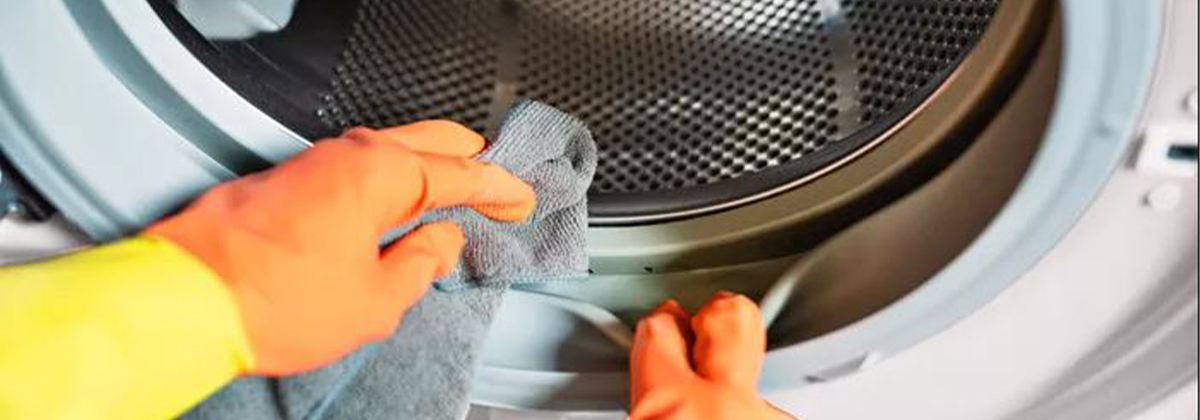06 Oct Washing Machine Mold Removal
A washing machine is one of the most used household appliances used at least twice weekly. Although the job of this machine is to clean clothes from dirt and the detergents are constantly circulating inside it, you must clean it periodically. Unpleasant smells, skin problems, itching, and even lung problems may result from mold in the washing machine; you can’t easily see molds with the eyes, but the wet and dark environment of the washing machine is the best place for them to multiply. This article explains the washing machine mold removal steps and its smell at home and introduces the necessary detergents. Stay tuned to the end.
The cause of mold formation in the washing machine
With the passage of time and multiple washes, the dirt on the clothes accumulates in the corners of the washing machine. To know the cause of washing machine mold, you should pay attention to the fact that molds need dark, moist, and warm environments to grow and multiply, and washing machines are one of the environments with all these conditions in one place! The plastic pipes of the washing machine door are the best place for mold to grow, and unfortunately, because the rubber around it is multi-layered, they can’t be seen with the eye when cleaning the machine, and they may stay in that area for a long time and multiply.
Sometimes it’s impossible to access all the washing machine parts and dry all its features. Therefore, it can be a suitable place for the growth of mold and fungi. The main problem is that these molds can stick to clothes and cause lung, respiratory and allergy problems. You may experience even wearing a clean outfit making you feel itchy. This condition may be caused by washing machine mold between the clothes fibers. Therefore, following some tips is necessary to prevent mold formation in the washing machine.
Factors for the formation of molds
Among the essential things that may cause the formation of fungus and mold in laundry are:
- Not cleaning the pot and rubber around the washing machine door after washing
- Not drying the laundry pot and walls
- Leaving wet clothes in the machine for a long time
- Excessive use of detergents and their accumulation in different parts of the laundry
- Close the washing machine door immediately after washing
- Wear and tear of washing hoses and water leakage from the machine
- Long-term non-cleaning of washing machine filters
Washing machine mold removal steps
Mold removal from the washing machine at home is a simple and easy task. You can follow the three steps below and have a clean, mold-free device.
Cleaning the plastic washer of the washing machine door
To clean the washing machine’s mold, remove the washer and clean it using a towel, a solution of warm water and soap, or a suitable detergent such as dishwashing or handwashing liquid. After rinsing the washer and putting it back in place, ensure it’s scorched and moisture-free.
Cleaning all parts of the washing machine
After you wash and dry the washer, you should use a soft cloth, sponge, or toothbrush and suitable detergents to clean all machine parts, including the powder tank, thoroughly.
Removing mold residues using the washing program
Considering that the remaining molds can be a source of food for the re-growth of molds, you must be sure that the machine is cleaned. Therefore, you must perform an empty washing cycle in the last step of removing the mold from the washing machine. It’s better than this cycle is programmed on the hottest and longest setting. Also, to get cleaner and remove the smell of mold from the washing machine, you can use a cup of baking soda or half a cup (dishwashing liquid, washing machine liquid, or scented cleaners).
Clean the detergent drawer
Part of the detergent you pour into the washing machine remains in the powder compartment. This residue, in combination with moisture, provides a suitable place for the growth of molds. In most washing machine models, this drawer is easily removed. (If you have trouble removing the drawer, read the washing machine manual.) Wash the powder compartment entirely and clean all its seams with a toothbrush or brush. If you can’t remove some parts from the detergent, put them in hot water for a few minutes. After washing, dry the drawer and expose it to the sun.
Clean the washing machine filter
In most cases, lint, hair, paper towels, coins, etc., get stuck in the washing machine filter. To prevent the accumulation of mold and pollution in this area, you should remove the lint inside it with a toothbrush and wash it well. Then let it be exposed to sunlight for a few hours.
Detergents needed to remove washing machine mold.
According to the explanations provided in the washing machine cleaning and mold removal section, you have seen that the detergents needed to remove the washing machine mold include cleaning agents such as dishwashing liquid, soap, various softeners, washing machine liquid, or powder. You can use them in different stages of washing. Therefore, choosing the brand and quality of the detergent is more critical than its type. Since molds are the source of foul odors, we recommend using fragrant detergents to remove their foul smell. Therefore, it easily removes the unpleasant smell left in the washing machine.
Various ways to prevent washing machine mold
There are many instructions and tips to prevent mold in the washing machine; the following are the most important ones:
Airflow
The fact that air must flow inside the washing machine can significantly prevent it from becoming moldy; therefore, it’s enough to leave the door open for airflow in the washing machine.
Quick emptying of the washing machine from wet clothes
Another important thing in preventing the washing machine from becoming moldy is that the clothes don’t remain in the device long after the washing program is finished. You should empty the washing machine immediately so that moisture doesn’t stay in it.
Run a wash cycle with bleach
In general, bleaches are a kind of disinfectant and mold killer. Therefore, it’s better to run a bleach wash cycle every once in a while (once a year) to prevent the machine from getting moldy.
Dry the washer regularly
It was mentioned in the previous parts that the washing machine washer is prone to mold, so it’s recommended to keep the washing machine washer dry with a towel after each wash.
Use enough detergent
In general, if more detergents are poured into the tank than required or if powder or liquid remains in the tank after washing, they cause mold; So, to prevent the washing machine from getting moldy, we recommend paying attention to the required amount of detergent for washing clothes. After finishing the washing program, you should check that the powder tank is clean.
Use of high-quality detergents
It’s interesting to know that the quality of detergents affects the mold growth of the washing machine, and it’s recommended to use high-quality detergents.
Mold removal of the washing machine with the help of lemon
Since molds grow quickly and often grow in places such as the rubber around the door or the end of the powder tank, which aren’t ordinarily visible, It’s recommended to thoroughly check the washing machine once in a while to prevent further mold growth.
Remove the foul smell of washing machine mold.
The unpleasant smell may remain even after removing the mold from the washing machine. You can use simple ways to remove the scent of mold from the washing machine.
First method
The first way is to use scented detergents to remove mold from the washing machine, eliminating the unpleasant smell.
Second method
The second way is to use vinegar, bleach, or baking soda. For this purpose, as mentioned in the previous sections, use the empty wash program for the washing machine and add baking soda, bleach, or vinegar to the detergent you have chosen to eliminate the smell.
If you still feel an unpleasant odor after one wash cycle, you can repeat the cycle and leave the washing machine door open for at least one to two hours. Do this method until there’s no nasty smell left in the washing machine and you finish the mold removal process.
To wrap up
The presence of mold in the washing machine and the unpleasant and annoying smell can have dangerous consequences for you and your family. Skin, allergies, respiratory problems, etc., are the results of mold remaining on the washed clothes. Fortunately, by doing a few simple things, you can avoid all these problems and have a clean and smelling washing machine. If you don’t have the opportunity or patience to wash your clothes, you can count on the specialized NeatEx team. With the most advanced tools and the latest knowledge, we will deliver your clothes of the best quality as soon as possible. Don’t damage your valuable clothes with improper washing. NeatEx washes your clothes best and ensures you have clean and tidy clothes.




Sorry, the comment form is closed at this time.